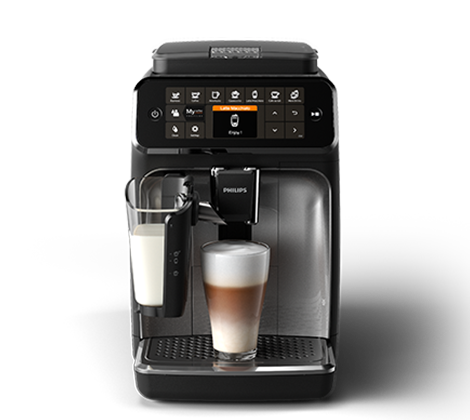#1: Philips 3200

- Easy to use
- Affordable
- Compact design
#2: Philips 4300

- More drink options
- Intuitive touchscreen
- Customizable settings
If you’re considering a fully automatic espresso machine, Philips 3200 and Philips 4300 might be on your radar. These two models are popular among coffee enthusiasts for their ease of use, quality, and customization options. As someone who has personally used both machines, I’ll walk you through their features, differences, and which one I found to be the best fit for my everyday coffee needs. Let’s dive in to see how the Philips 3200 holds up against the Philips 4300.
Getting Started with Philips 3200 vs 4300
Setting up both the Philips 3200 and Philips 4300 was easy, even for someone like me who’s not particularly tech-savvy. Both models come with step-by-step instructions and are ready to brew coffee within minutes. The Philips 3200 has a straightforward touch panel that simplifies the process, while the Philips 4300 offers a bit more control in the setup phase, allowing you to personalize certain drink settings from the start.
One thing I noticed right away was that the Philips 3200 seems ideal for people who want to enjoy great coffee without navigating a complex setup. The Philips 4300 has extra features, which may appeal to coffee aficionados who enjoy a more hands-on experience. Personally, I preferred the simplicity of the 3200, which allowed me to get a quality cup of coffee quickly.

Coffee Quality and Drink Consistency
Both machines brew excellent coffee, but I found the Philips 3200 slightly easier for consistent results across multiple cups. It produces a rich espresso with a thick crema, especially when using fresh, high-quality beans. The Philips 4300 also delivers great coffee, but with added options to customize strength, temperature, and volume. Although these customization options might be appealing for people who want to fine-tune every detail, I preferred the no-fuss consistency that the Philips 3200 provided for my daily brews.
I experimented with different types of beans, from light roasts to dark roasts, and both machines did a good job extracting flavor. However, I found that the Philips 3200’s standard settings produced a balanced, full-bodied espresso without needing to make many adjustments. For someone who values simplicity and quality, this was a big plus.

Philips 3200 vs 4300: The LatteGo Milk Frothing System
Performance of the LatteGo System
Both the Philips 3200 and Philips 4300 are equipped with the LatteGo Milk Frothing System. This is one of my favorite features on these machines because it produces a creamy, airy froth that works well with various milk types, including almond and oat milk. The LatteGo system is also incredibly easy to use. It’s a two-piece system without hoses, which means it’s easy to clean and requires minimal maintenance. The milk froth quality on both machines was almost identical, creating the perfect cappuccino and latte with little effort.
In my experience, the LatteGo system works equally well on both models, so if you’re specifically looking for a machine with reliable milk frothing, either model would meet your needs. I particularly liked that both machines allow you to adjust the milk froth amount. This feature lets you create a denser foam for cappuccinos or a lighter, creamier froth for lattes.
Ease of Cleaning the Milk Frother
Cleaning the milk frother was a breeze on both models. With traditional milk frothing systems, you often have to deal with tubes that can be tricky to clean. The LatteGo has no tubes, so it only takes a quick rinse, and it’s even dishwasher-safe. This feature saved me time, especially on busy mornings. If you’re someone who drinks a lot of milk-based coffee drinks, this easy cleanup is a real advantage.

Additional Features and Differences: Philips 3200 vs 4300
Custom Profiles and Drink Variety
One of the key differences between the Philips 3200 and Philips 4300 is the ability to create custom profiles. The Philips 4300 allows you to save a personal profile, which is helpful if you want to keep your preferred coffee settings. This feature is useful in a household where multiple people have different coffee preferences. For me, however, the Philips 3200’s standard options were more than enough. I didn’t feel the need to save a custom profile, as I usually drink the same types of coffee each day.
In terms of drink variety, both machines offer the basics: espresso, cappuccino, latte macchiato, and black coffee. The Philips 4300 provides slightly more customization in terms of strength, temperature, and drink size, which might appeal to users looking for more control. However, the Philips 3200 covers the essentials well, and I never felt like I was missing out on any major features.
User Interface: Simple vs. Feature-Rich
The user interface on both machines is intuitive, but I found the Philips 3200’s interface a bit easier to navigate. It’s minimalist and straightforward, which made it quick to choose my drink and get on with my day. The Philips 4300, on the other hand, has more options, which some people might appreciate. Personally, I liked that the Philips 3200 kept it simple. For me, this was a big advantage, as it helped speed up my morning coffee routine.
Maintenance and Descaling
Both the Philips 3200 and Philips 4300 have convenient maintenance reminders for cleaning and descaling, ensuring that you keep the machine in top condition without much effort. I appreciated the automatic rinse cycle, which kept the coffee spouts clean after each use, preventing coffee residue from building up.
Descaling is required on both models after a certain amount of usage, depending on your water hardness settings. While the Philips 4300 has a few extra cleaning reminders, I found that the Philips 3200 provided enough guidance for regular maintenance without overwhelming me. The brew group in both machines is also removable, making it easy to rinse under the faucet for thorough cleaning.
Comparing Value: Which Model is Worth the Investment?
it comes to price, the Philips 3200 generally costs less than the Philips 4300. After testing both, I concluded that the Philips 3200 offers better value for everyday coffee needs. Its ease of use, quality, and essential features meet my expectations without the added expense. While the Philips 4300 offers a few additional customization options, they didn’t significantly enhance my experience, especially given the higher price tag.
For households with diverse coffee preferences, the Philips 4300 might be worth the extra cost due to its profile-saving feature and additional customization. However, if you’re looking for a reliable, straightforward machine that delivers consistent results, the Philips 3200 is an excellent choice.
Product Review Conclusion: Philips 3200 vs 4300
In conclusion, after using both the Philips 3200 and Philips 4300, I found the Philips 3200 to be the better fit for my needs. It’s user-friendly, provides high-quality coffee and milk froth, and is easy to maintain. While the Philips 4300 offers more customization, the added features didn’t make a significant difference in my daily coffee routine.
For those who appreciate simplicity, consistency, and a great balance of features, the Philips 3200 is an ideal choice. It’s well-suited for coffee lovers who want excellent drinks without needing extensive customization. However, if you’re someone who likes to tweak every aspect of your coffee or has a household with different preferences, the Philips 4300’s extra features might appeal to you. For my needs, though, the Philips 3200 provided the best combination of quality, value, and ease of use.
FAQs and their answers for the Philips 3200 vs 4300 coffee machines:
Q1: What are the main differences between the Philips 3200 and Philips 4300?
A1: The main differences are in customization and profile features. The Philips 4300 offers additional strength and temperature settings and allows you to save custom profiles, which is useful for households with multiple coffee drinkers. The Philips 3200 offers fewer customization options but is simpler to use and provides the essential coffee drink choices.
Q2: Can both Philips 3200 and 4300 make milk-based drinks like lattes and cappuccinos?
A2: Yes, both machines have the LatteGo Milk Frothing System and can make milk-based drinks like cappuccinos, lattes, and latte macchiatos. The LatteGo system is easy to use, produces quality froth, and is simple to clean as it doesn’t have any milk tubes.
Q3: What coffee drinks can the Philips 3200 and Philips 4300 make?
A3: Both machines can make espresso, coffee, cappuccino, and latte macchiato. The Philips 4300 provides a few more options for customizing strength, temperature, and drink size, while the Philips 3200 covers the basic drink choices well.
Q4: Is the Philips 4300 worth the higher price compared to the Philips 3200?
A4: The Philips 4300 may be worth the higher price for those who value extra customization features, especially if multiple people in a household want different coffee settings. However, for those who want a simpler machine with essential features, the Philips 3200 provides excellent value.
Q5: Are both Philips 3200 and 4300 easy to clean and maintain?
A5: Yes, both models are easy to clean. They come with removable brew groups that can be rinsed under water, and the LatteGo milk system is dishwasher-safe. Both machines have automatic rinse cycles to keep the coffee spouts clean, and they will alert you when descaling is needed.
Q6: Do the Philips 3200 and 4300 have a grinder, and can I adjust the grind size?
A6: Both machines come with built-in ceramic grinders that preserve coffee flavor. You can adjust the grind size with five different settings, allowing you to control the strength and taste of your coffee.
Q7: Can I use pre-ground coffee with the Philips 3200 and 4300?
A7: Yes, both models have a bypass doser that allows you to use pre-ground coffee. This is helpful if you occasionally want to use decaf coffee or a specific ground blend.
Q8: How noisy are the Philips 3200 and 4300 machines?
A8: Both machines operate at a similar noise level, which is fairly standard for automatic espresso machines. The grinder does make some noise during operation, but it’s not overly loud or disruptive.
Q9: How much space do the Philips 3200 and 4300 take up on the countertop?
A9: Both machines are relatively compact for fully automatic machines, measuring around 9.7 inches in width, 14.6 inches in depth, and 17 inches in height. They are designed to fit comfortably on a standard kitchen countertop.
Q10: Do the Philips 3200 and 4300 have a warranty?
A10: Yes, Philips typically offers a two-year warranty on their coffee machines, including the 3200 and 4300 models. This warranty covers manufacturer defects and provides peace of mind for new buyers.
